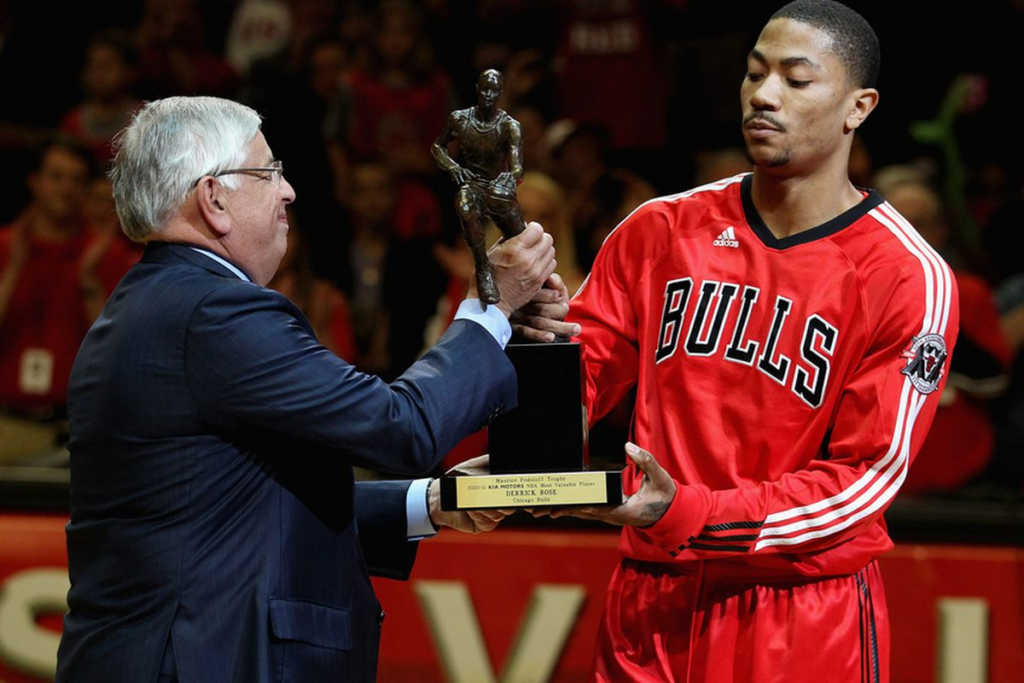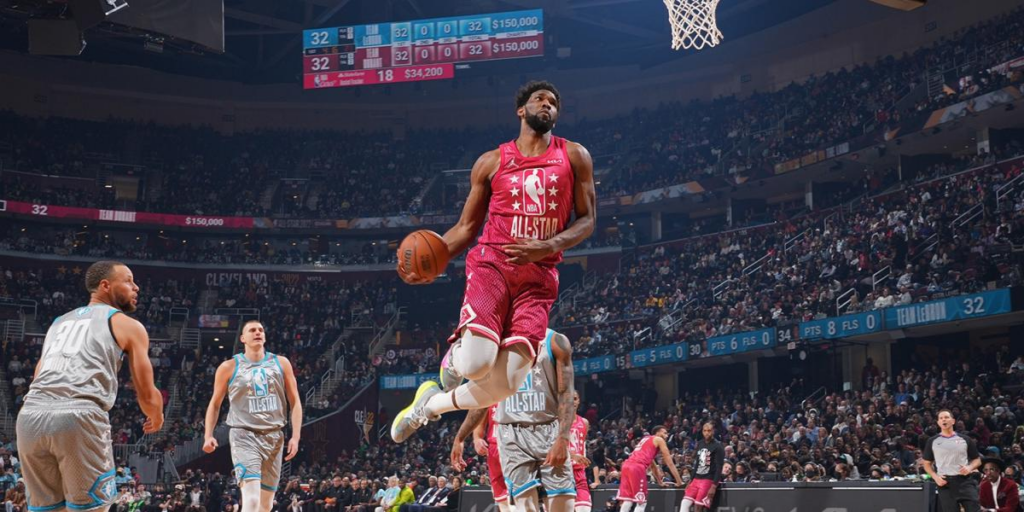The Derrick Rose rule, formally known in the CBA as the “5th Year, 30% Max Criteria” allows teams to financially compensate their young superstars coming off their rookie deal better. Working alongside the “Designated Rookie Extension” it means a team can offer a higher 30% percent of the salary cap to a player if they are able to hit the specified criteria, instead of the standard 25%.

These criteria are discussed below.
The Derrick Rose Rule. 5th Year, 30% Max Criteria
- Named to an All-NBA team in the most recent season, or in two of the past three seasons.
- Named Defensive Player of the Year in the most recent season, or in two of the past three seasons.
- Named Most Valuable Player in any of the past three seasons.
- Extension covers at least four new years, max 5 (as per designated rookie extension)
- Free agent contracts can also be eligible for the Rose-rule max, if coming off the four-year rookie contract, or is a former second-round pick or undrafted free agent with four years of experience, and re-signing with the current team.
Players can sign their Designated Rookie Extension after the 3rd year of their Rookie Scale Contract. If they have not, at that point, met the criteria listed above, the contract can be changed retrospectively if they qualify for it in the 4th and final year of their Rookie Scale Contract. This is usually the case. Notably 2018 Draft class mates Luka Doncic and Trae Young are now noth on Designated Rookie Extensions using the Rose Rule. Doncic became the first and currently only player to qualify before signing the contract, while Young qualified the year after signing by making the NBA 3rd team in his 4th season.
Why Is This Rule Named After Rose?
Derrick Rose inspired the creation of the 5th Year, 30% Max rule by putting together one of the best seasons by a young player in league history. In 2011, just his third year in the NBA, Rose was able to win MVP. The former number one overall pick became the youngest player to ever win this award and did so with his hometown team, the Chicago Bulls. His official age at the time of claiming this award was 22 years and 191 days.
For those that aren’t aware, the previous holder of this particular record was Wes Unseld, winning it in 1969 at the age of 23 years and nine days, playing with the Baltimore Bullets. Due to this being Unselds first season in the league, he also won rookie of the year.
Roses season was absolutely phenomenal no matter which way that you look at it. The Bulls wanted to make sure he stuck around long-term after this deal and signed him to a massive five-year, $94.3 million extension. Though, some could argue that he might have even been worth more at the time considering his MVP status at such a young age.
The year after he won the MVP, the league implemented the Derrick Rose Rule. The NBA saw how great he was able to pay and wanted to make sure that Chicago could compensate a young superstar like this. The need to allow franchises to offer their drafted stars big money to keep them is seen as a priority league wide. The Rose Rule is seen as a big step toward this. The 5th Year, 30% Max rule allows young stars like Rose to get more money from the team that drafted them so they don’t have to hit free agency.
Can you use the Derrick Rose rule by being an Allstar?
No, although the initial rule included in the 2011 CBA stated that you could be eligible for the extra 5% contract if you made the Allstar team the previous year, or 2 of the previous 3 years, this was removed in the 2017 CBA. You can no longer qualify for the 5th year, 30% Max through selection to the Allstar game.

Is the Rose Rule the same as the Designated Rookie Extension?
No, the Rose Rule works alongside the designated Rookie Extension. The use of Designated Rookie extensions is much more common and mainly serves the purpose of allowing a team to extend their Rookies contract a year early AND give them 5 years of extension. Essentially forming a 6 year contract (Final year of rookie scale, plus new 5 year extension). This is the longest contract type allowable under the CBA. It has other stipulations, but the basics are that to sign a player to this type of contract a team would need to hold their Bird Rights, (drafted them on traded for them while they were on their rookie deals). The other big and often confusing element to the designated rookie extension is that it limits the amount a team can have on their roster at any one time. A team can only sign 2 players to Designated Rookie Extensions and you can only trade for 1 player on a Designated Rookie Extension. This most recently came into play when Kevin Durant asked for a trade away from the Nets, as Ben Simmons, who the Nets traded for, was on a Designated Rookie Extension, it ruled out several players that otherwise might have made sense in a KD trade. It is important to note though, that this isn’t due to the Rose Rule. While you have to be on a designated rookie extension to benefit from the Rose Rule, not every player on a Designated Rookie Extension has been paid the extra money through the Rose Rule.
Prior to the KD mess, the Designated Player Rookie Extension hit the headlines in 2019 when Anthony Davis wanted out of New Orleans while on his Designated Rookie Extension.
The Celtics had recently traded for Kyrie Irving who had been able to ink a Designated Rookie Extension with the Cleveland Cavaliers. After adding Kyrie onto the roster, Boston made it clear that they wanted to just go all in during this offseason and add even more talent. Anthony Davis and Kyrie had expressed an interest in playing together and it seemed like a brilliant pairing that would boost the Celtics already young and talented roster. The issue was that the Celtics couldn’t have two players they had traded for on Designated Rookie Extensions, so it would have needed Kyrie to go the other way in any trade.
This is often reported as being because of the Rose Rule, whereas in fact the Rose Rule is irrelevant in this situation as it is simply the Designated Rookie Extension that limits the number on any roster at once.
What NBA Players have signed contracts using the Derrick Rose Rule?
The below 4 players have all signed contracts using the Derrick Rose Rule, 5th Year, 30% Max:
Under the 2011 CBA
Derrick Rose 2011 with the Chicago Bulls qualified by winning the 2011 MVP award
Blake Griffin 2013 with the L.A. Clippers qualified by making the All-NBA second team in 2011-12 & 2012-13
Paul George 2014 with Indiana Pacers qualified by making the All-NBA third team in 2012-13 & 2013-14
Under the 2017 CBA
Luka Dončić 2021 with the Dallas Mavericks became the first player to be eligible for such a contract before signing due date, as he had been named to the All-NBA first team in 2019–20 and 2020–21
Trae Young 2021 with the Atlanta Hawks, qualified by making All NBA 3rd team in 2021-22.

In addition the following players are known to have signed 5 year/25% contracts – Designated Rookie Extensions, without taking advantage of the Rose Rule.
Joel Embiid (Philadelphia 76ers) until 2023
Damian Lillard (Portland Trail Blazers) until 2021
Anthony Davis (New Orleans Pelicans) until 2021
Kyrie Irving (Boston Celtics) until 2020
John Wall (Washington Wizards) until 2019
James Harden (Houston Rockets) until 2018
Russell Westbrook (Oklahoma City Thunder) until 2017
